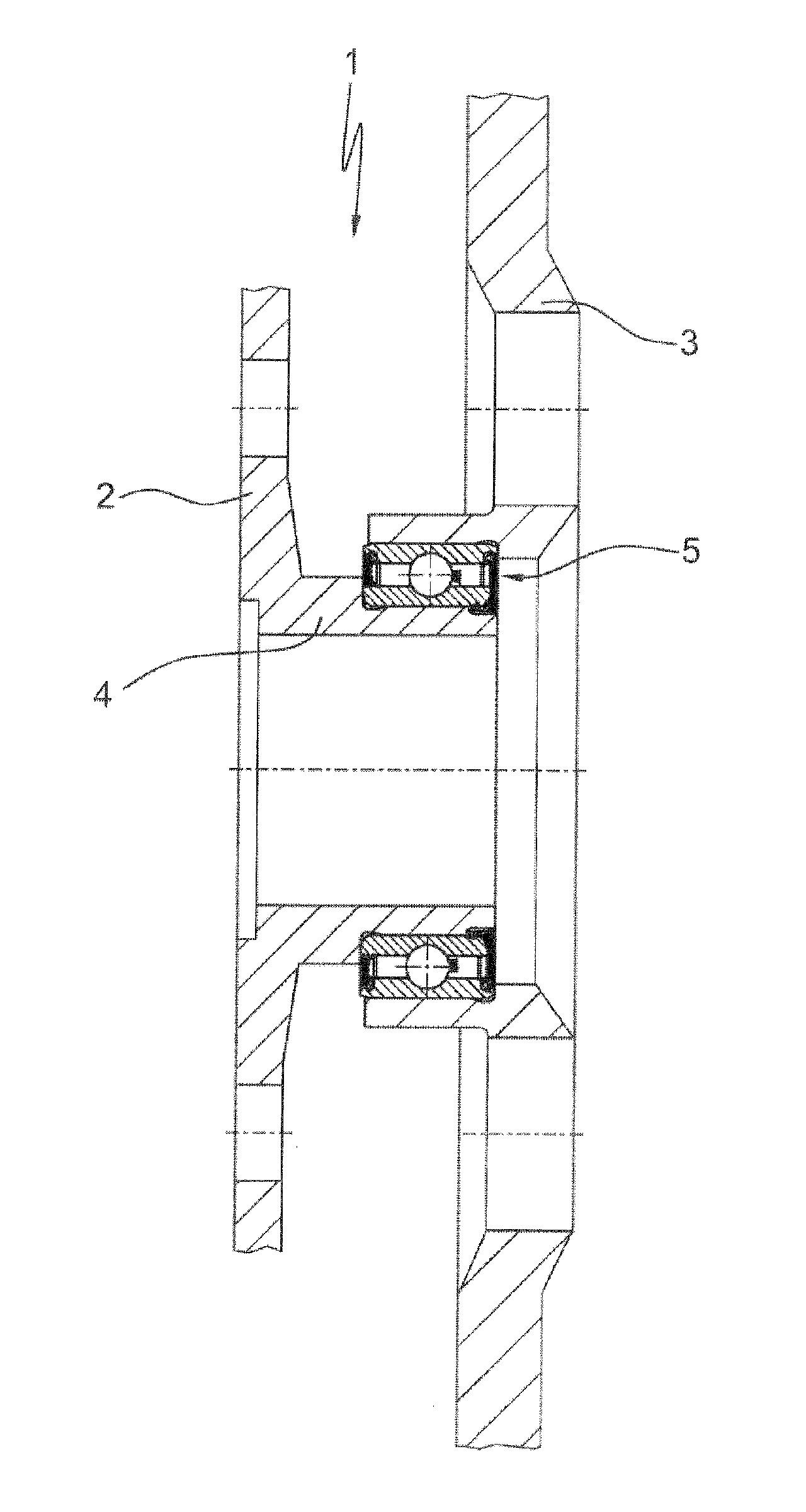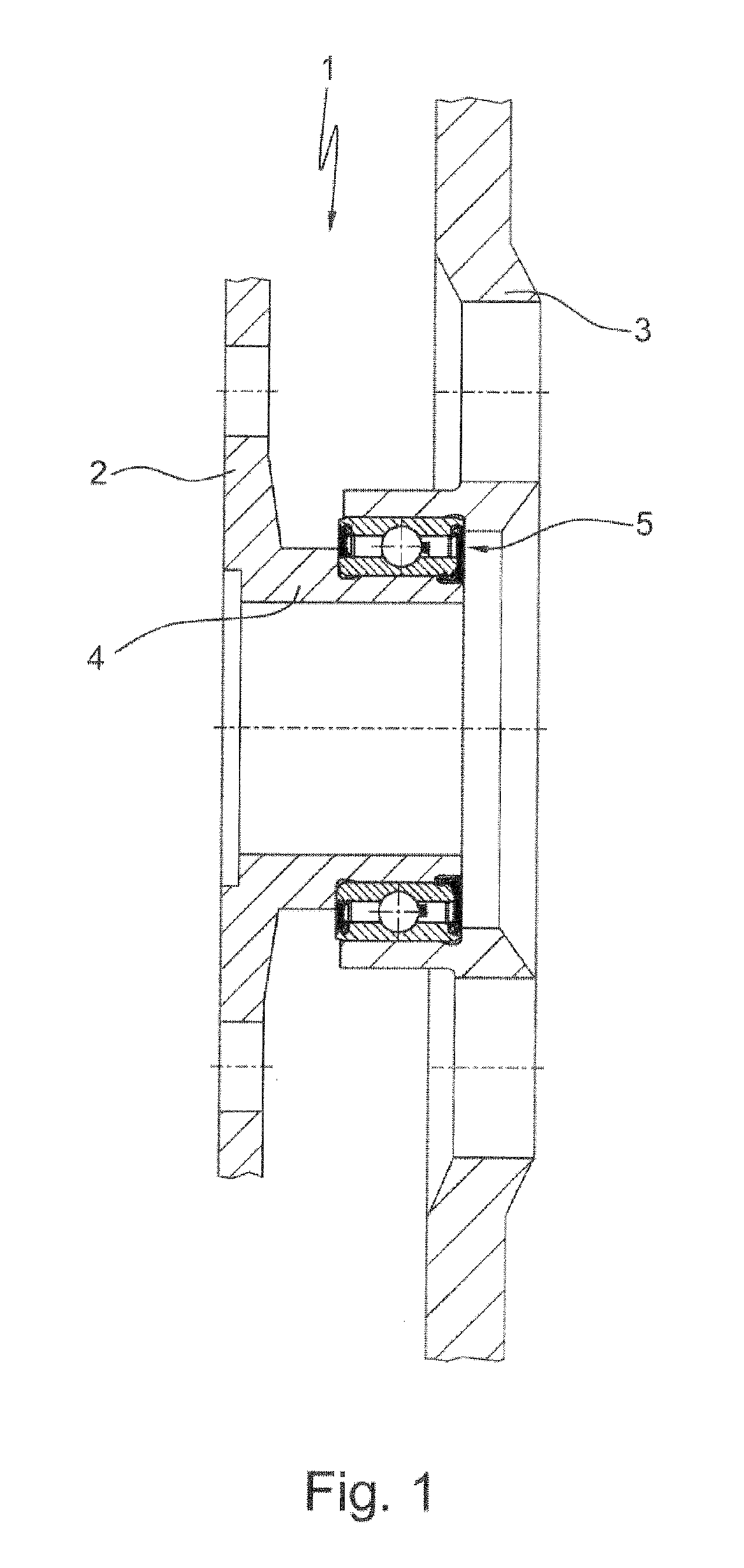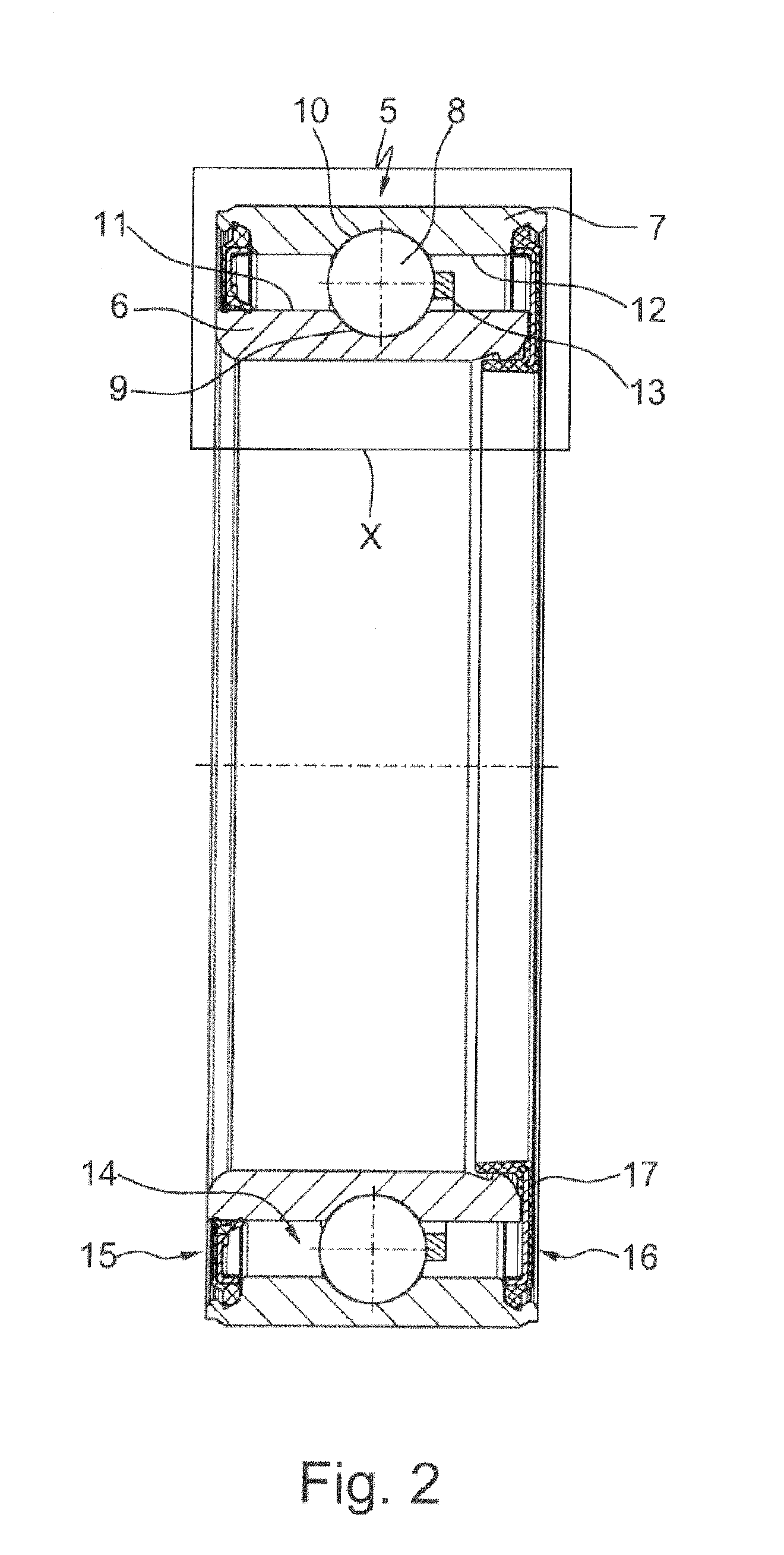[0010]According to claim 2, it is provided in the rolling bearing designed according to the invention that preferably only the seal at the secondary mass side is designed as an angle-profile-shaped
lip seal, whereas the seal at the primary mass side is formed by a lip sealing ring which is known per se and which at one side is snapped into a receiving groove in the inner lateral surface of the outer bearing ring and which at the other side has two sealing lips which bear slidingly against the outer lateral surface of the inner bearing ring. Such a seal
pairing has proven to be particularly cheap and functionally adequate because the known lip seals provide optimum sealing against the escape of lubricant from the bearing and simultaneously prevent the ingress of
dirt from the nearby
clutch bell into the hearing. It would however also be conceivable for both seals of the rolling bearing to be formed as angle-profile-shaped lip seals.
[0011]According to claim 3, it is a further feature of the rolling bearing designed according to the invention that the radial seal leg of the angle-profile-shaped
lip seal is stiffened by a
metal reinforcement and can be snapped with its
free edge section into a further encircling receiving groove in the inner lateral surface of the outer bearing ring. Here, the
metal reinforcement serves to provide the radial stiffness of the lip seal which is otherwise composed of a vulcanized-on
elastomer, and ensures that the gap seal formed to the axial side of the inner bearing ring has a uniform gap dimension.
[0012]According to claim 4, the rolling hearing designed according to the invention is furthermore characterized in that, in relation to the outer bearing ring, the inner bearing ring has an axial width which is reduced by the thickness of the radial seal leg of the lip seal and by the gap dimension of the gap seal. In this way, it is ensured that the rolling bearing has a continuously uniform axial width when the lip seal has been inserted. Furthermore, the inner bearing ring is formed, on its inner lateral surface, with a bearing seat width which is reduced by approximately the length of the axial sealing lip of the lip seal, in order to provide the necessary installation space for the axial sealing lip. That part of the inner lateral surface of the inner bearing ring which is in
sliding contact with the axial sealing lip may either have the same
diameter as the bearing seat, such that the bearing
flange on the primary mass should be formed with an
undercut corresponding to the thickness of said sealing lip, or the inner lateral surface of the inner bearing ring is provided with a stepped
undercut such that, when the lip seal has been inserted, the underside of the axial sealing lip is at approximately the same level as the bearing seat.
[0013]Furthermore, in one expedient refinement of the rolling bearing designed according to the invention as per claim 5, it is provided that that part of the inner lateral surface of the inner hearing ring which is in
sliding contact with the axial sealing lip of the lip seal is additionally formed with an encircling groove and with a bevel running to the axial side of the inner bearing ring, in order thereby to reduce the frictional surface of the axial sealing lip against the inner bearing ring. An approximately wedge-shaped annular contour is thus formed on the inner lateral surface of the inner bearing ring between the encircling groove and the bevel, against which wedge-shaped annular contour the axial sealing lip of the lip seal bears only with low-friction linear contact with respect to the inner bearing ring. The elasticity of the axial sealing lip and unavoidable lubricant leakages escaping via the gap seal furthermore ensure that the axial sealing lip has virtually no wear over the service life of the rolling bearing.
[0014]Finally, it is also proposed in claims 6 and 7, as an advantageous in a variant of the rolling bearing designed according to the invention, that the lip seal has, on the inner side of its radial seal leg, an additional pre-sealing lip, and that an additional centrifugal groove is formed into the outer lateral surface of the inner bearing ring directly in front of the pre-sealing lip of the lip seal. Here, the additional pre-sealing lip has a profile cross section approximately in the shape of a monopitch roof and is intended to prevent liquid or low-
viscosity lubricant from being able to directly drip down into the gap seal between said seal leg and the axial side of the inner bearing ring. In contrast, the centrifugal groove in the outer lateral surface of the inner bearing ring preferably has a semi-circular profile cross section and, during bearing operation, forms a separation edge which is intended to prevent lubricant from creeping into the gap seal under
centrifugal force. Furthermore, such a centrifugal groove may also be formed into the outer lateral surface of the inner bearing ring directly in front of the lip seal at the primary mass side, in order, on this side of the bearing too, to form a separation edge to prevent the lubricant from creeping under the sealing lips under
centrifugal force.
[0015]In summary, the deep groove ball bearing designed according to the invention for a dual mass
flywheel therefore has the
advantage over deep groove ball bearings known from the prior art that it has a lip seal which is simultaneously designed as an
overpressure valve which, despite being in
sliding contact with the inner bearing ring, is almost free from wear owing to the elasticity of its axial sealing lip, and which ensures reliable ventilation of the rolling bearing if an admissible
gas pressure in the
interior space thereof is exceeded. In this way, it is simultaneously possible to dispense with the cumbersome formation of individual ventilation bores which are at risk of becoming blocked, such that the lip seal is extremely cheap to manufacture overall. Furthermore, it is possible, by
dimensioning the axial scaling lip of the lip seal differently, to correspondingly limit the level of the admissible
gas pressure in the
interior space of the rolling bearing. Likewise, it is possible for the lip seal to be mounted in a simple and reliable manner on the rolling bearing without the risk of sealing lips being folded over, and said lip seal, as a result of the fact that it is visible from the outside, simultaneously allows the rolling bearing to be mounted reliably and in the correct position in the dual mass flywheel.
 Login to View More
Login to View More  Login to View More
Login to View More 


